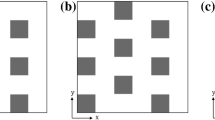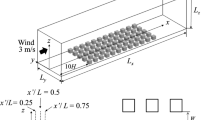Abstract
Recently, several attempts have been made to model the wind velocity in an urban canopy in order to accurately predict the mixing and transport of momentum, heat, and pollutants within and above the canopy on an urban scale. For this purpose, unverified assumptions made by Macdonald (Boundary-Layer Meteorol 97:25–45, 2000) to develop a model for the profile of the mean wind velocity within an urban canopy have been used. In the present study, in order to provide foundations for improving the urban canopy models, the properties of the spatially-averaged mean quantities used to make these assumptions have been investigated by performing large-eddy simulations (LES) of the airflow around square and staggered arrays of cubical blocks with the following plan area densities: λ p = 0.05, 0.11, 0.16, 0.20, 0.25, and 0.33. The LES results confirm that the discrepancy between the spatial average of wind velocity and Macdonald’s five-point average of wind velocity can be large in both types of arrays for large λ p . It is also confirmed that Prandtl’s mixing length varies significantly with height within the canopy, contrary to Macdonald’s assumption for both types of arrays and for both small and large λ p . On the other hand, in accordance with Macdonald’s assumption, the sectional drag coefficient is found to be almost constant with height except in the case of staggered arrays with high λ p .
Similar content being viewed by others
References
Amsden AA, Harlow FH (1970) A simplified MAC technique for incompressible fluid flow calculations. J Comput Phys 6: 322–325
Castro IP, Cheng H, Reynolds R (2006) Turbulence over urban-type roughness: deduction from wind tunnel measurements. Boundary-Layer Meteorol 118: 109–131
Cheng H, Castro IP (2002) Near wall flow over urban-like roughness. Boundary-Layer Meteorol 104: 229–259
Cionco RM (1965) Mathematical model for air flow in a vegetative canopy. J Appl Meteorol 4: 517–522
Coceal O, Belcher SE (2004) A canopy model of mean winds through urban areas. Q J Roy Meteorol Soc 130: 1349–1372
Coceal O, Thomas TG, Castro IP, Belcher SE (2006) Mean flow and turbulence statistics over groups of urban-like cubical obstacles. Boundary-Layer Meteorol 121: 491–519
Coceal O, Dobre A, Thomas TG, Belcher SE (2007) Structure of turbulent flow over regular arrays of cubical roughness. J Fluid Mech 589: 375–409
ESDU (1986) Mean fluid forces and moments on rectangular prisms: surface-mounted structures in turbulent shear flow. Engineering Sciences Data Item Number 80003
Fadlun EA, Verzicco R, Orlandi P, Mohd-Yusof J (2000) Combined immersed-boundary finite-difference methods for three-dimensional complex flow simulations. J Comput Phys 161: 35–60
Finnigan J (2000) Turbulence in plant canopies. Annu Rev Fluid Mech 32: 519–571
Germano M, Piomelli U, Moin P, Cabot WH (1991) A dynamic subgrid-scale eddy viscosity in model. Phys Fluids A 3: 1760–1765
Hamlyn D, Britter R (2005) A numerical study of the flow field and exchange processes within a canopy of urban-type roughness. Atmos Environ 39: 3243–3254
Hanna SR, Tehranian S, Carissimo B, Macdonald RW, Lohner R (2002) Comparisons of model simulations with observations of mean flow and turbulence within simple obstacle arrays. Atmos Environ 36: 5067–5079
Kanda M (2006) Large-eddy simulation on the effects of surface geometry of building arrays on turbulent organized structures. Boundary-Layer Meteorol 118: 151–168
Kanda M, Moriwaki R, Kasamatsu F (2004) Large-eddy simulation of turbulent organized structures within and above explicitly resolved cube arrays. Boundary-Layer Meteorol 112: 343–368
Kono T, Ashie Y, Tamura T (2007) Large eddy simulation of airflow around regular arrays of cubical buildings. In: APCOM’07 in conjunction with EPMESC XI, 3–6 December, Kyoto, Japan (MS4-2-3 in CD-ROM)
Kono T, Ashie Y, Tamura T (2009a) Derivation of spatially averaged momentum equations of multilayer urban canopy model using spatial-averaging operation corresponding to filtering operation of LES. Summaries of Technical Papers of Annual Meeting, Architectural Institute of Japan, 2009 D-1:949–950 (in Japanese)
Kono T, Ashie Y, Tamura T (2009b) Derivation of spatially averaged momentum equations of urban canopy model using the concept of the immersed boundary method. In: 7th international conference on urban climate, 29 June–3 July 2009, Yokohama, Japan (P3-21 in CD-ROM)
Leonard A (1974) Energy cascade in large-eddy simulations of turbulent fluid flows. Adv Geophys 18A: 237–248
Lien F-S, Yee E, Wilson JD (2005) Numerical modelling of the turbulent flow developing within and over a 3-D building array, part II: a mathematical foundation for a distributed drag force approach. Boundary-Layer Meteorol 114: 245–285
Lilly DK (1992) A proposed modification of the Germano subgrid-scale model. Phys Fluids A 4: 633–635
Macdonald RW (2000) Modelling the mean velocity profile in the urban canopy layer. Boundary-Layer Meteorol 97: 25–45
Miguel AF, van de Braak NJ, Silva AM, Bot GP (2001) Wind-induced airflow through permeable materials. Part 1: the motion equation. J Wind Eng Ind Aerodyn 89: 45–57
Raupach MR, Shaw RH (1982) Averaging procedures for flow within vegetation canopies. Boundary-Layer Meteorol 22: 79–90
Sabatino SD, Solazzo E, Paradisi P, Britter R (2008) A simple model for spatially-averaged wind profiles within and above an urban canopy. Boundary-Layer Meteorol 127: 131–151
Sagaut P (2005) Large eddy simulation for incompressible flows, an introduction, 3rd edn. Springer, New York, pp 15–31
Van der Vorst HA (1992) Bi-CGSTAB: a fast and smoothly converging variant of Bi-CG for the solution of nonsymmetric linear systems. SIAM J Sci Stat Comput 13(2): 631–644
Author information
Authors and Affiliations
Corresponding author
Rights and permissions
About this article
Cite this article
Kono, T., Tamura, T. & Ashie, Y. Numerical Investigations of Mean Winds Within Canopies of Regularly Arrayed Cubical Buildings Under Neutral Stability Conditions. Boundary-Layer Meteorol 134, 131–155 (2010). https://doi.org/10.1007/s10546-009-9434-y
Received:
Accepted:
Published:
Issue Date:
DOI: https://doi.org/10.1007/s10546-009-9434-y




